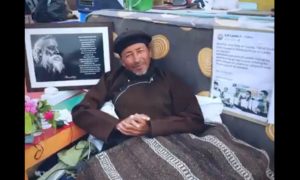The thawed showdown is not only affecting the Pashmina industry but also the livelihood of nomads.
In the deceptive calm of the cold desert, an old woman is keeping a close eye on her Pashmina pack dotting a pastureland near the frozen flashpoint. Her sagged stature and furrowed face tell the tale of times and troubles that has now become a chronicle of her Changpa tribe.
Unlike her present slumped state, she was a nimble on her feet when the Sino-regulars first showed up in 1962. She remembers running for her life along with her parents.
Nearly six decades later, the arrival of PLA—Peoples Liberation Army—has instilled new troubles and trepidations.
“Who knew that life would be back to square one for all of us here,” says the old shepherd in her late seventies. “It’s more worrying this time around, as these Chinese are literally inside our fields.”
Even as the brutal showdown—that saw nail-studded clubs, rods and spears being used as the frontier firearms—has thawed, the dragon’s lurking presence at the Line of Actual Control (LAC) is unnerving these nomads.
In response to Beijing’s belligerence, New Delhi’s manifested militarization has cleared paths for some top commandos, now hawking what used to be a godforsaken nomad land before May 2020.
That month as the boots on the ground grew, the nomads feared to lose the winter grazing lands for their pashmina goats.
Still oblivious with the LOCisation of their former pasturelands, the nomads of Changthang are now trying to adjust with the new normal.
But before the Chinese aggression, this remote area of Ladakh would be celebrated as a cashmere cradle.
Changthangi goats, often referred as Pashmina goats, are the source of the finest Pashmina fiber. They’re reared on the Trans Himalayan region called Changa, hence the name Chanthangi.
The wool is obtained by shearing and its demand has skyrocketed because of the fashion industry in recent times.

Aerial view of Leh market in Ladakh. This place is known for its good pashmina industry. [FPK Photo/Vikar Syed.]
The Pashmina owners are wholly dependent on the shepherds of Changthan. These nomads take their cattle for grazing in the nearest areas of the Indo-China border. They earn anything between Rs 600 and Rs 800 per day.
These goats have survived on the meager pasture and have braved the harsh climate for centuries.
“We face difficulties in grazing goats in this area, as it is not suitable for the cattle,” says Rigzen, a shepherd from Chushul, Leh. “We aren’t able to cultivate any vegetables or other food items.”

Rigzen along with his flock of goats in the last village of Chushul, Ladakh. [FPK Photo/Vikar Syed.]
Grazing goats on the finest grass is important for producing the finest Pashmina, says Zasal, owner of Pashmina showroom, in Leh town.
While stocking Pashmina shawls in his outlet, he continues, “Tensions in the border area can definitely impact the pashmina industry. We’ve to prepare and buy Pashmina before a year for next year’s production. But the biggest losers are those poor shepherds who benefit and profit by grazing these goats.”

Laborers building the infrastructure near the LAC in Ladakh. [FPK Photo/ Vikar Syed.]
But with dragon on the doorsteps, New Delhi is currently constructing new infrastructure near LAC in Ladakh.
Labourers from Bihar, Jharkhand and other states have been working near the zero line for the last six months to construct new roads, bridges and other infrastructure.

A view of newly constructed road near Pangong Lake in Ladakh. [FPK Photo/Vikar Syed]
Already, melting glaciers, erratic rainfall, increasing temperature and human interference has made it difficult for the Pashmina goats to survive.
The climate-cum-conflict change has moved and pushed these nomads in the plains where the pastures are very scared.

Goats grazing the meadows near the Pangonk road near LAC in Ladakh. [FPK Photo/Vikar Syed.]
In the backdrop of the border belligerence, the Changthang shepherds are staring at the bleak future. The glum group mainly comprises of elderly men and women whose only source of income comes from grazing the flock.
“The hostility has put our survival at stake,” says the old woman shepherd while gazing at her grazing goats. “We’re losing our identity and yet, we aren’t able to do anything about it.”






